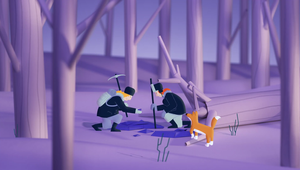
How Picturesmith Brought a Paper World to Life for Picturehouse Cinemas

Picturesmith makes animations that stand out for ambitious brands and agencies around the world. Their London studio has prop-making facilities as well as two stop-motion stages. As an award-winning studio, they get to work with some of the world’s biggest brands on ambitious projects.
Here, the team at Picturesmith share how they made the animated pre-film ident for the British boutique cinema, Picturehouse.
Story
This story is centred around two friends meeting on a rainy evening at a Picturehouse cinema to enjoy a film, food and drinks.
With the idea approved, storyboarding began. Initially, using quick pencil drawings to work out how the story would be told visually. This story was packed with details, highlighting the Picturehouse experience.
To help the film stand up to repeat viewings, we worked with Picturehouse to sprinkle relevant film references throughout, giving their audience something new to discover each time they go to the cinema.
Once the script and storyboard were finalised, the next stage of development involved setting the design and art direction, which would establish the visual style and aesthetic of the animation.


Design
We made a film for Picturehouse previously using a paper-cut technique. This look was baked into much of their marketing material, so we wanted to continue with this aesthetic .
Knowing there would be a lot of paper cutouts to create, we opted for a simple yet distinctive style for the characters and backgrounds.
A limited colour palette created distinctive scenes throughout, creating a world that would look great on cinema screens and complement the Picturehouse brand.
With the characters and backgrounds designed, we developed a detailed layout for each scene, effectively conveying the narrative and visual elements.


Art Direction/Style
To effectively convey a lot of information within a limited time frame, we used split screens, a dynamic storytelling technique frequently used in films. By dividing the screen into various sections, we were able to visualise a complex narrative on a single frame. In our film, we utilised 17 split screens throughout its entirety.
With the art direction and design in place to create our Picturehouse world, the next step was to bring this world to life.

2D Animation to paper
Stop motion is not easily editable, so we only shoot what is needed. As such, we had to ensure the story was planned perfectly before we started shooting. To do this, we created the entire animation in 2D first.
Each character was composed of several separate pieces of paper. And for each second, there were 12 different drawings needed to create the animation.
With the 2D animation finalised, there was an intricate process of preparing the digital artwork to be cut out of paper by machine. These were then glued and numbered by hand. There were thousands of assets to prepare before we could start production.
One of the challenges with animating in this style is ensuring everything is accounted for and organised.


Production/Lighting
The director of photography (DoP) plays a crucial role in stop-motion animation, ensuring the scenes are lit to create the desired mood and atmosphere. This was made more complex because we were animating using a multi-plane. This involved adjusting the lighting to create the desired effect on each layer.
Once the lighting was set up, the DoP worked closely with the animators to ensure that the lighting was consistent throughout the animation and that the movement of the characters and objects didn’t cause unwanted shadows or lighting changes.


Animation
We used replacement animation, where our paper cutouts are photographed, removed and replaced with the next one in the sequence. The cutouts are carefully aligned in position to create the illusion of movement.
We utilised both stages in our studio. Animating on one while the other was being prepared. This helped to ensure our shoot schedule remained fluid.
Most scenes were shot using a multi-plane - multiple layers of glass suspended at various distances - this allowed us to achieve cinematic depth.
When animating on a multiplane, our animators had to move pieces on different glass layers for each frame, which is a complex and time-consuming process.

Post-production
Once all the scenes were animated and captured with a camera, we assembled the split-screen layout in the edit and colour-graded the film using DaVinci Resolve.
We worked with a brilliant composer, who worked wonders with a challenging brief “Make something like Take Five, by Dave Brubeck”
The audio was finished with a sound design that complimented the visuals and built the atmosphere of going to the cinema.

Final film
All of this hard work resulted in a 60-second cinema ident.
This ident gets aired across their network of 26 UK cinemas and is played around 350 times a day before each film. This adds up to over 10,000 plays every month.















